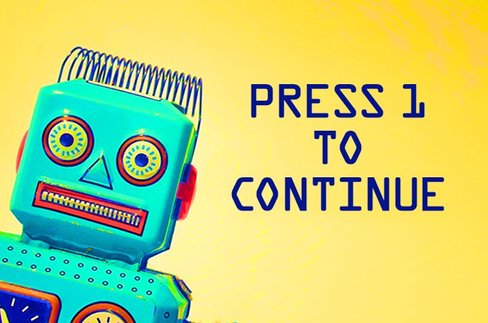In the quest to reduce costs, many organizations are automating customer service functions. But removing the human element from customer service can be bad for business. Here’s why.
I couldn’t believe what I’d just heard.
I was on the exhibition floor at Enterprise Connect Conference in Orlando in March, when I overheard a marketing executive proudly announce, “We’re automating 97% of our customer service functions….”
I had to keep myself from jumping in and explaining to the guy, forcefully, what a colossal mistake this would be. Some functions simply should not be automated, and customer service is one of them.
Yet it seems that more and more organizations are choosing to do so. When was the last time you called and didn’t get frustrated by the labyrinthian maze of “Press 1 for this… Press 2 for that…” options?
Sure, some customer service processes can be automated without inconveniencing or angering customers. Allowing them to, say, check account balances, add or drop services and make payments online are relatively easy, low-cost, high-return activities.
As the e-tailing group, a noted ecommerce consulting organization, notes: “While automation can be expedient, the resulting impersonal tone and risk of poor information are formidable.”
Had I interrupted our friend in Orlando, I would have given him and his colleagues three reasons why removing the human element from customer service is pure folly.
Reason #1: Humans Solve Problems
The most important part of customer service is resolving customers’ issues. Because humans have the ability to listen, understand, seek out information and apply accumulated knowledge and past experiences to situations, they’re far better problem-solvers than any machine could ever dream of being.
When an issue requires resolution, the risk to the organization is too big to entrust the task to a machine. At that point, the organization is at an important crossroads and can choose from two options:
– Delight the customer with friendly service, and 73% will fall in love with your brand.
– Anger the customer with poor service, and 91% will leave (and tell up to 15 people about it while heading out the door).
Given the choice, I’ll take the human any day.
Reason #2: Humans Can Empathize
What also makes people such outstanding problem-solvers is the uniquely human emotion of empathy. It’s the warm-and-fuzzy feeling that comes from a soothing voice who assures you they understand your problem and can fix it.
As the e-tailing group noted, the impersonal nature of automated machines makes them poor choices to handle vital customer service functions. The computerized voice that intones “I’m sorry you’re having trouble with your selection” isn’t sorry at all because it doesn’t have feelings and can’t empathize with my situation.
And while we’ve all witnessed what computers are able to do these days with things like machine learning, a digital voice will never express empathy the same way as a human voice does.
Reason #3: Humans Want Choices
Finally, there’s a very basic reason why customer service efforts must include the human touch. Consumers want choices in how they receive service, and some prefer to talk to another person – even if it’s to handle a mundane task like checking a checking account balance. Denying them the opportunity to do so is misguided. Sure, it may be more expensive to the organization, but it’s certainly less costly than losing a customer.
Additional information
To learn more about new ways of working, read Jabra Holger Reisinger’s blog by Clicking Here
For additional information visit the Jabra Website or view their Company Profile







